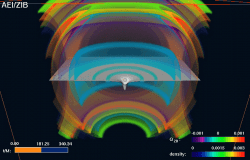Gravitational waves are predicted by Einstein’s 1916 general theory of relativity, but they are notoriously hard to detect and it’s taken many decades to come close to observing them. Now, with the help of a supercomputer named SUGAR (Syracuse University Gravitational and Relativity Cluster), two years of data collected by the Laser Interferometer Gravitational-Wave Observatory (LIGO) will be analyzed to find gravitational waves. Once detected, it is hoped that the location of some of the Universes most powerful collisions and explosions will be found, perhaps even hearing the distant ringing of celestial black holes…
Gravitational waves travel at the speed of light and propagate throughout the cosmos. Like ripples on the surface of a universe-sized pond, they travel away from their point of origin and should be detected as they traverse through the fabric of space-time, passing though our cosmic neighborhood. Gravitational waves are generated by massive stellar events such as supernovae (when giant stars run out of fuel and explode) or collisions between Massive Astrophysical Compact Halo Objects (MACHOs) like black holes or neutron stars. Theoretically they should be generated by any sufficiently massive body in the Universe oscillating, propagating or colliding.

LIGO, a very ambitious $365 million (National Science Foundation funded) joint project between MIT and Caltech founded by Kip Thorne, Ronald Drever and Rainer Weiss, began taking data in 2005. LIGO uses a laser interferometer to detect the passage of gravitational waves. As a wave passes through local space-time, the laser should be slightly distorted, allowing the interferometer to detect a space-time fluctuation. After two years of taking data from LIGO, the search for the gravitational wave signatures can begin. But how can LIGO detect waves being generated by black holes? This is where SUGAR comes in.
Syracuse University assistant professor Duncan Brown, with colleagues in the Simulating eXtreme Spacetimes (SXS) project (a collaboration with Caltech and Cornell University), is assembling SUGAR in the aim to simulate two black holes colliding. This is such a complex situation that a network of 80 computers, containing 320 CPUs with 640 Gigabytes of RAM is required to compute the collision and the creation of gravitational waves (as a comparison, the laptop I’m typing on has one CPU with two Gigabytes of RAM…). Brown also has 96 Terabytes of hard disk space on which to store the LIGO data SUGAR will be analyzing. This will be a massive resource for the SXS team, but it will be needed to calculate Einstein’s relativity equations.
“Looking for gravitational waves is like listening to the universe. Different kinds of events produce different wave patterns. We want to try to extract a wave pattern — a special sound — that matches our model from all of the noise in the LIGO data.” – Duncan Brown
By combining the observational capabilities of LIGO and the computing power of SUGAR (characterizing the signature of black hole gravitational waves), perhaps direct evidence of gravitational waves may be found; making the first direct observations of black holes possible by “listening” to the gravitational waves they produce.
Source: Science Daily


hahahhahaha
Yet another of Einstein’s “mistakes” is proven to have been correct all along.
Except, Garygzr, no-one has detected them yet.
what is that supposed to be good for? helping to evolve? surely not..most of the researchers should have enough brains, to be able to tell that we as a human race will not make it far enough as such data has any relevance for us in the future. instead, this is just a personal thing, the greed for information, the satisfaction of your crave for knowledge.
Hmm . . . maybe gravity waves don’t exist. It could be Einstein is wrong. Misinterpreting mathmatics is a fairly easy thing.. I’m not saying the math is incorrect that gravity waves are based on. But, the more complex an algorithm, the greater the chance for a misleading result regardless of computer fire-power. Assuming the math is correct, is it possible the universe is awash in a sea of gravity waves just outside of our perception of (4) dimensions? Keep in mind, while we can work very accurately with gravity math, gravity is still a mystery.
Gravity waves have wave lengths in tens of light years.
The only places we will find shorter wavelengths are when we are approaching Black Holes.
Gravity waves are the distortion of the overal EMF. ( SpaceTime, Cosmic Background Radiation, The fabric of Spacetime) & are delineated by stars in the arms of spiral nebulae.
The wavelengths are so long that the human race will probably be run before one comlete cycle passes our planet..
That is why it is so dificult to detect them from here.
Klaro, shouldn’t you be in the “The End of the World is Nigh” blog?
Cuz you certainly don’t belong here.
And Tony, why is it that these researchers keep making these foolish mistakes without consulting you first?
And if what you say is true, then shouldn’t it take 10 years to detect a wave passing? Or maybe 30 to get a wave pattern? Funny, no one has detected one, but you can tell us how they act with such certainty.
Klaro, not that your comment rates an answer but wouldn’t it be great if we ALL had such GREED for KNOWLEDGE!! Is there some problem with that? We should all resign our foolish selves to simple stupidity? Thanks, I’ll hang with the enquiring minds. Go Science!!
klar0 has a right to be on here as much as we have a right to criticize.
I used to have a greed for knowledge. Now that I’m getting older, I have a greed just to have enough brain cells left to keep from lapsing into a conservative.
Boy that’s a lot of “factual” statements about “gravity waves” which are something that have never been shown to exist. Here we go again — just speculation, no real physics in here!
Tony Trenton Says:
February 12th, 2008 at 10:44 am
‘Gravity waves have wave lengths in tens of light years…’
Umm, Gravity waves have wavelengths that correspond to the period of oscillation or the associated timescale of the movement of massive objects. Therefore, rapidly orbiting black holes or neutron stars will have short period oscillations and correspondingly short wavelengths. Maybe that is what you meant when you said ‘The only places we will find shorter wavelengths are when we are approaching black holes’. Whatever the case is, these are the objects that they are looking for with LIGO, due to both the relatively short length of the arms of the instrument and the time period over which the data has been taken.
The main difficultly in detecting gravitational waves lies not in the fact that they are long period waves, but because gravity is (apparently) an intrinsically weak force, so the amplitude of any oscillations in the LIGO detector will be extremely small – for a typical event they are predicting that the 4 Km LIGO arms will change in length about 0.1% the diameter of a proton. And that’s if they even exist at all! We can be reasonably confident that they do, seeing as a) relativity has been accurate in all of it’s tested predictions, and b) it is believed that gravitational waves have been indirectly observed (Hulse, Taylor – ’93 Nobel Prize for Physics). However, despite this suggestive evidence, they have still never been directly observed. Here’s hoping!
)
We already have men in space and the identification of these waves might just have an effect on the planning of future space programs. Also, things we learn about out in the farther universe can have an effect on the knowledge of our own planet and its stability in this wild universe. Many things have come from theory to proven reality and in doing so have affected the further planning of projects and studies and advancements. For one, think of the germs and viruses. Once microscopes and medical sciences proved them, medicine took some gigantic leaps into treatment of their effects. Let us not be too hasty to naysay this study. Who are we to say it is “a bunch of bunk”!